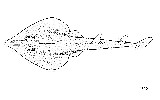Rhinobatos annandalei
Norman, 1926
Annandale's guitarfish
Classification: Elasmobranchii Rhinopristiformes Rhinobatidae
Reference of the original description
A synopsis of the rays of the family Rhinobatidae, with a revision of the genus Rhinobatus. Proceedings of the Zoological Society of London, 96(4), 941–982
A synopsis of the rays of the family Rhinobatidae, with a revision of the genus Rhinobatus. Proceedings of the Zoological Society of London, 96(4), 941–982
Image of the original description
Image in copyright.
Image in copyright.
Synonyms / new combinations and misspellings
Rhinobatos cf. annandalei, Rhinobatus annandalei
Rhinobatos cf. annandalei, Rhinobatus annandalei
Description :
Citation: Rhinobatos annandalei Norman, 1926: In: Database of modern sharks, rays and chimaeras, www.shark-references.com, World Wide Web electronic publication, Version 01/2026
Please send your images of "Rhinobatos annandalei" to info@shark-references.com

Rhinobatos annandalei Norman, 1926, male, TL: 59.7 cm, DW: 24.2 cm, Weight: 755g, 05th January 2020, Cox's Bazar BFDC, Bangladesh © G. M. MASUM BILLAH, Program Coordinator- Marine Mega-Fauna & Fisheries, Wildlife Conservation Society- Bangladesh Program (masumwcsbd@gmail.com)

Rhinobatos annandalei Norman, 1926, male, TL: 59.7 cm, DW: 24.2 cm, Weight: 755g, 05th January 2020, Cox's Bazar BFDC, Bangladesh © G. M. MASUM BILLAH, Program Coordinator- Marine Mega-Fauna & Fisheries, Wildlife Conservation Society- Bangladesh Program (masumwcsbd@gmail.com)
Common names
 Annandale"s guitarfish,
Annandale"s guitarfish,  Annandale"s shovelnose ray,
Annandale"s shovelnose ray,  Bengal guitarfish
Bengal guitarfish
 Annandale"s guitarfish,
Annandale"s guitarfish,  Annandale"s shovelnose ray,
Annandale"s shovelnose ray,  Bengal guitarfish
Bengal guitarfish
Short Description
Diagnosis after Last et al. 2019 [27190]: A medium-size species of the genus Rhinobatos (attaining at least 870 mm TL) distinguished by the following combination of characters: disc large, broadly wedge-shaped, width 38–44% TL, length 1.1–1.2 times width; snout relatively short, length 2.5–2.8 times interspiracular distance, 3.5–3.9 times interorbital width; orbit diameter 1.1–1.8 times spiracle length; nostrils weakly oblique, their length 1.3–1.5 times internarial distance; mouth width 7.1–8.0% TL; preoral length 5.6–5.7 times internarial distance; posterior nasal flaps broad; two spiracular folds, outermost fold slightly taller than inner fold; ridges of rostral cartilage; anterior cartilage sickle shaped, bilobed posteriorly; distance between fifth gill slits 2.4–2.8 times in ventral head length; prebranchial sensory pore system obvious, extending posteriorly to margin of first gill slit; postscapular sensory canal obvious, notched, with exposed lateral pores; conspicuous thorn patches on supraorbit and scapular region, and row of short pungent thorns along dorsal midline; dorsal fins almost entirely covered with minute denticles; dorsal fins moderately tall, height of first 7.0–8.6% TL; pelvic-fin inner margin subequal to or shorter than its base length; interdorsal distance 2.2–2.4 times first dorsal-fin base; dorsal caudal margin 2.0–2.7 times preventral margin; upper jaw with 126–130 tooth rows; snout angle ~70°; 67–70 pectoral radials; 158–165 post-synarcual centra; 54–59 nasal lamellae; dorsal fins almost entirely brownish or greyish; dorsal disc brownish or greyish, with a symmetrical pattern of small, widely spaced white spots (rectangular arrangement of four spots on head lateral to orbito-spiracular region and a triangular arrangement of three spots on nape); ventral disc and tail pale, often with variable dark blotches; no large, black, teardrop marking on undersurface of snout.
Diagnosis after Last et al. 2019 [27190]: A medium-size species of the genus Rhinobatos (attaining at least 870 mm TL) distinguished by the following combination of characters: disc large, broadly wedge-shaped, width 38–44% TL, length 1.1–1.2 times width; snout relatively short, length 2.5–2.8 times interspiracular distance, 3.5–3.9 times interorbital width; orbit diameter 1.1–1.8 times spiracle length; nostrils weakly oblique, their length 1.3–1.5 times internarial distance; mouth width 7.1–8.0% TL; preoral length 5.6–5.7 times internarial distance; posterior nasal flaps broad; two spiracular folds, outermost fold slightly taller than inner fold; ridges of rostral cartilage; anterior cartilage sickle shaped, bilobed posteriorly; distance between fifth gill slits 2.4–2.8 times in ventral head length; prebranchial sensory pore system obvious, extending posteriorly to margin of first gill slit; postscapular sensory canal obvious, notched, with exposed lateral pores; conspicuous thorn patches on supraorbit and scapular region, and row of short pungent thorns along dorsal midline; dorsal fins almost entirely covered with minute denticles; dorsal fins moderately tall, height of first 7.0–8.6% TL; pelvic-fin inner margin subequal to or shorter than its base length; interdorsal distance 2.2–2.4 times first dorsal-fin base; dorsal caudal margin 2.0–2.7 times preventral margin; upper jaw with 126–130 tooth rows; snout angle ~70°; 67–70 pectoral radials; 158–165 post-synarcual centra; 54–59 nasal lamellae; dorsal fins almost entirely brownish or greyish; dorsal disc brownish or greyish, with a symmetrical pattern of small, widely spaced white spots (rectangular arrangement of four spots on head lateral to orbito-spiracular region and a triangular arrangement of three spots on nape); ventral disc and tail pale, often with variable dark blotches; no large, black, teardrop marking on undersurface of snout.
Distribution
Indian Ocean: northern Indian Ocean, Oman to eastern India (Bay of Bengal) including the Andaman Sea, off Myanmar [27190]; Bangladesh (see image) Source: www.gbif.org
Indian Ocean: northern Indian Ocean, Oman to eastern India (Bay of Bengal) including the Andaman Sea, off Myanmar [27190]; Bangladesh (see image) Source: www.gbif.org
Biology
Exhibit ovoviparity (aplacental viviparity), with embryos feeding initially on yolk, then receiving additional nourishment from the mother by indirect absorption of uterine fluid enriched with mucus, fat or protein through specialised structures [733].
Exhibit ovoviparity (aplacental viviparity), with embryos feeding initially on yolk, then receiving additional nourishment from the mother by indirect absorption of uterine fluid enriched with mucus, fat or protein through specialised structures [733].
Remarks
shark-references Species-ID=5904;
shark-references Species-ID=5904;


















